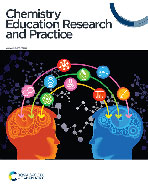A social semiotic lens to capture meaning-making of polymeric concepts during modelling in chemistry education
Abstract
This study investigated students’ meaning-making of polymeric concepts during modelling and discuss students’ creation of visible representations in chemistry. The analysis combines a phenomenographic and social semiotic approach and leads to the finding and description of 21 different meaning-making processes. We refer to meaning-making as the outcome of translative communication through representations, discerned by students, where the collective meaning of created representations that build on each other constitutes the meaning as a whole. The study took place in three Swedish upper secondary chemistry classes. Data were collected from eight groups of 3–4 students (n = 30). Video, audio recordings and photos taken during modelling were analysed to investigate students’ meaning-making during the modelling process. The results show translative changes between and within semiotic resources, indicating meaning for students’ learning of polymeric concepts. Additionally, the representations produced during modelling were essential resources connecting the submicro and macro levels by creating a ‘bridge’ between levels. The results show that the modelling activities practised by all groups were multimodal. The study acknowledges that teachers can use the social semiotic lens as a tool to evaluate students’ modelling in addition to the importance of translative processes during modelling.


 Please wait while we load your content...
Please wait while we load your content...